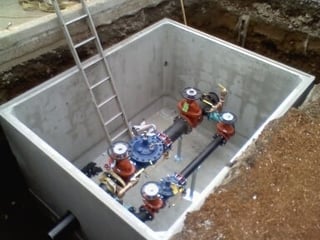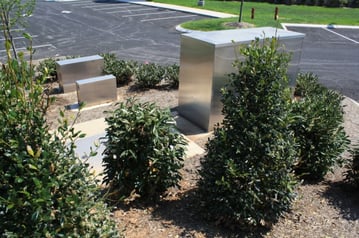If you’re installing backflow preventers in utility vaults, you could be making a fatal mistake. Here's why:
Let's say your next project includes a design for a fire-sprinkler system and domestic service. You decide to stick with the design you've used in the past and install the double-check detector backflow preventer in a utility vault. It's been a common practice for decades, but you're unaware of the risks you're taking.
Nearly 100 people die in utility vaults each year, but designers don't have to do it this way anymore. There are actually a few options, but most engineers don’t even realize they exist. Let's look at some of them and more importantly, why vaults are so dangerous.
The problem with Utility Vaults
Things go wrong, we all know that. No system or practice is perfect. Of course utility vaults will be the same. But at the same time, should we continue using a flawed system when there is an alternative? It's still an unpopular opinion, but we think not.
People tend to repeat the things they've done in the past. Procedures become "standard practice" over time and no one thinks much about them. If the water utility accepts backflow preventers in vaults, and even has standard details showing backflow preventers in utility vaults, why would anyone hesitate to design them that way? If it was wrong, it wouldn't be accepted, right? The water purveyors and plan's reviewers are only considering the device itself. Just because they think a backflow preventer can do just fine in a vault, doesn't mean that's where it should be. That's because:
- Backflow assemblies need annual testing and maintenance
- Utility vaults flood
- Mud builds up inside vaults
- Animals make nests in utility vaults
- Backflow preventers malfunction
 According to data collected by the U.S. Department of Labor (USDOL), Bureau of Labor Statistics (BLS) Census of Fatal Occupational Injuries (CFOI) program, nearly 100 fatal injuries occur in confined spaces each year.
According to data collected by the U.S. Department of Labor (USDOL), Bureau of Labor Statistics (BLS) Census of Fatal Occupational Injuries (CFOI) program, nearly 100 fatal injuries occur in confined spaces each year.
In addition to the deaths, 780 serious injuries are reported annually in confined spaces. Deaths can be caused by oxygen deficiency or the presence of noxious gasses. People die from combustible dusts and even radiation. The injuries occur from a wide variety of physical hazards. Remember, these are trained professionals entering vaults and other confined spaces.
The risks associated with underground vaults are defined by OSHA. They are a confined space, and things go wrong in a confined spaces. Sadly, when they go wrong, it's often deadly.
It's the responsibility of the civil engineer on the project to be aware of the risks involved. The risk of injury, the risk of death, and the risk of your relationship with your valued client.
Install your Backflow Preventer In A Safe Place
To ensure you're installing your backflow preventer in a safe place, here's a list of things to do. First, do some homework and learn more about confined spaces. Here are some resources:
- OSHA's definition of confined spaces - the general overview of confined spaces
- OSHA's permit-required confined space - oddly enough utility vaults are almost never deemed to fit this description. It's up to the local
 government to decide whether their utility vaults will be permit-required
government to decide whether their utility vaults will be permit-required - Hazards and their solutions article list- some of the common causes of injury and death in confined spaces and how to avoid them
Next, learn about the alternative backflow installation options. The safest option is installing it in an above-ground enclosure.
Above-ground enclosures that are designed and manufactured to meet the requirements of ASSE 1060 are popular in many locations across the U.S. They may not be common in your part of the country and, therefore, you might not have been aware of this option. On your current project, make the change and rest better knowing these risks have been removed.
Or request a consultation and ensure your next project is done right.




